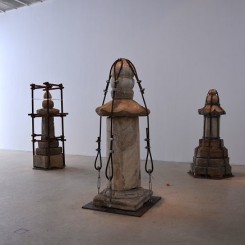Chambers Fine Art (No.1-D Caochangdi, Airport Access Road, Chaoyang District, Beijing), May 24–July 6, 2014
Viewed from a distance, the paintings Chambers Fine Art’s spacious right hall resemble a fanatical religious nighttime gathering. Closer inspection reveals the petals of a sliced preserved duck egg upon ink-dark, coarsely applied canvases. They are rendered like endearing, sweet nighttime whispers. The oil paintings are presented in a clockwise ordering, beginning with an egg in a nest and showing its transformation into a preserved egg, which then begins to rot and retreat into the increasingly deep darkness. The works are titled variously as preserved egg, rotten egg, rotten preserved egg and so forth, in a repetition that seems to circle just as the paintings themselves do. Here appears to be a worthwhile narrative: the artist creates a series of simple paintings, rousing the viewer’s emotion as he deploys a familiar culinary tradition with a centuries-old history, as though narrating the story of the egg as mummified and then freed from purgatory. The egg that Zhao Zhao paints does not symbolize regeneration, but rather relays a sort of spoken “obscenity” betraying a harsh humor which, once the viewer understands, precisely hits upon more ironic, internal aspects of the artist. The Chinese title of Zhao Zhao’s exhibition could be prescribed a number of meanings, yet they would all portend acertain “disquiet” for viewers.
The left hall of the Chambers Fine Art displays several Ming and Qing-era stupas, or edifices which in the past cased the relics of Buddhist disciples. Also known as reliquary stupas or votive stupas, they served as places of meditation for Buddhists. The small stone stupas are now creatively bound up and supported by other materials, almost resembling the trunk of a precious transplanted sapling. Steel bases provide support, horizontal wooden beams act as scaffolding, and all is held together by vertical rope and string resembling a bandage. A closer look reveals internal supports of wooden wedges placed at the joints between the stones. These objects—having rested upon the earth, imbibed the rain, sheltered under pine boughs, and gazed at the stars—have been moved into a closed gallery space; in these times they are disconnected, and as the outside world changes the stupas become sleepy piles of stone. Their origins unknown and their age counted in centuries, some of these stone stupas must have been partially dismantled and sold in pieces as miserable artifacts, even as a gallery from New York attempts to organize and reset them. This process hints at the devastation wrought upon the bastion of traditional Chinese philosophy for a few decades in the twentieth century—the which now, having realized and appreciated how the West and Japan preserved threads of traditional humanism, is undergoing a repair (with complex motives) from the outside in.
In civilizations with a tradition of building stupas, building a stupa brings good fortune in one’s reincarnation, while destroying one is considered as an extremely negative karmic act, with the soul rushing headlong towards an unfortunate future life. For these stupas “made” to be reincarnated into a white cube, what is crucial lies no longer in whether one opts to meditate in their midst; rather, the key is how one can see what the stupas symbolize—and how that is without its own ability to prop itself up, how without external support that will inevitably fall. Though the exhibition’s English title evokes a sense of “uncertainy”, Zhao Zhao himself is certain—knowing full well how to convey from a subtle opening that of which he is certain.





